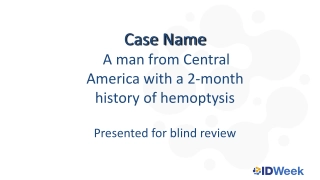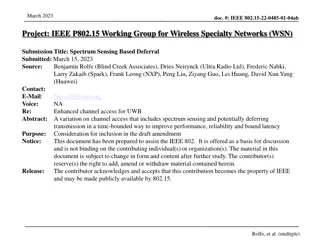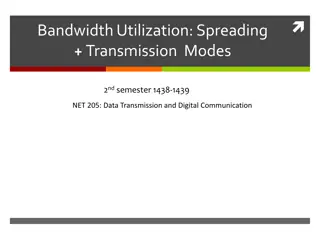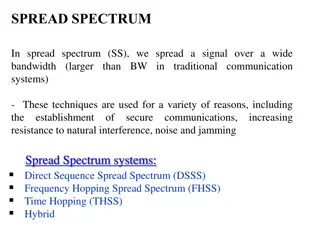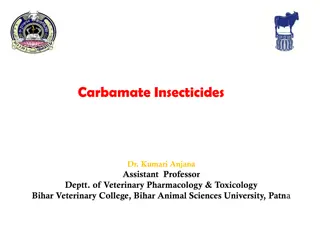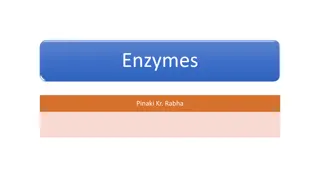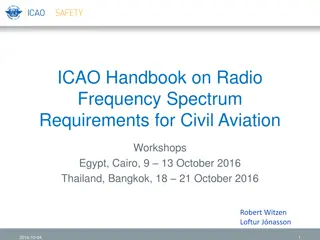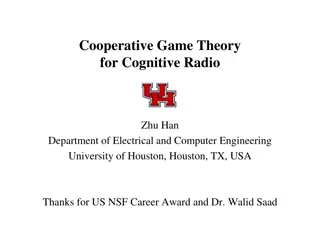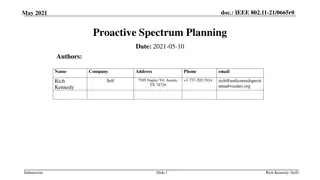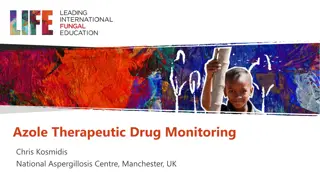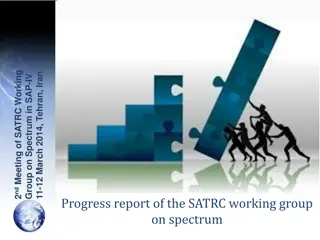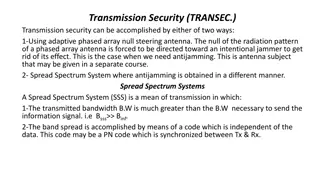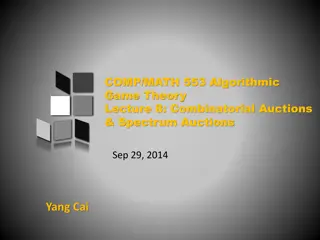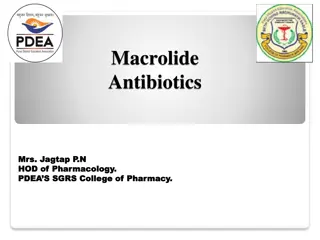Itraconazole: Structure, Mechanism of Action, and Spectrum of Activity
Itraconazole, a synthetic triazole, inhibits lanosterol demethylation in fungi leading to fungistatic activity. It has a broad spectrum of activity against various fungi including Candida, Cryptococcus, dermatophytes, and Aspergillus species. This overview covers the structure, mechanism of action, and spectrum of activity of itraconazole along with intended learning outcomes. Take a closer look at how this antifungal agent works and its implications in treating fungal infections.
Download Presentation

Please find below an Image/Link to download the presentation.
The content on the website is provided AS IS for your information and personal use only. It may not be sold, licensed, or shared on other websites without obtaining consent from the author.If you encounter any issues during the download, it is possible that the publisher has removed the file from their server.
You are allowed to download the files provided on this website for personal or commercial use, subject to the condition that they are used lawfully. All files are the property of their respective owners.
The content on the website is provided AS IS for your information and personal use only. It may not be sold, licensed, or shared on other websites without obtaining consent from the author.
E N D
Presentation Transcript
Itraconazole David W. Denning National Aspergillosis Centre, Manchester, UK
Part 1: Intended learning outcomes To appreciate the structure of itraconazole To understand the mechanism of action of itraconazole To be aware of the spectrum of activity of itraconazole
Itraconazole structure A synthetic triazole Second generation Triazole N N H3C N Molecular weight of ~706 g/mol O O H3C N N N N O HO N H F F Posaconazole Structurally similar to ketoconazole and posaconazole
Mechanism of Action Preferentially binds fungal cytochrome P450-enzyme lanosterol C-14- demethylase Inhibits the conversion of lanosterol to ergosterol major constituent of fungal cell membrane Resulting in the accumulation of fungal 14 alpha-methyl sterols, the loss of normal fungal sterols, and fungistatic activity. Mammalian cell demethylation is much less sensitive to Itraconazole inhibition.
Mechanism of Action Acetyl-CoA Squalene Squalene monooxygenase Squalene -2,3 oxide Lanosterol C-14 demethylase Azoles Ergosterol
Spectrum of activity Yeast Candida spp. + C. krusei Cryptococcus spp. Dimorphic B. dermatitidis, Coccidioides spp., Histoplasma spp. Dermatophytes Microsporum spp, Epidermophyton spp and Trichophyton spp. Moulds: Aspergillus spp, Sporothrix spp; minimum activity on Fusarium spp , no activity on Scedosporium spp Mucorales: Minimum activity. Itraconazole = fluconazole + Aspergillus coverage + better activity against endemic fungi
Spectrum of activity of triazole Fungi Fluconazole +++ +/- - +++ - - + ++ + +/- - - - Itraconazole Voriconazole +++ + +/- ++ +++ +++ +++ ++ +++ +++ - - - Posaconazole +++ + +++ ++ +++ +++ ++ ++ ++ + + + ++ Candida albicans Candida glabrata Candida krusei Cryptococcus spp Aspergillus fumigatus Aspergillus terreus Blastomyces spp Coccidioides spp Histoplasma spp Sporothrix spp Fusarium spp Scedosporium spp Mucorales +++ + +++ ++ +++ +++ + + + - +/- +/- -
Part 2: Intended learning outcomes To understand the Pharmacokinetics of itraconazole To be aware of the different formulations of itraconazole
Pharmacokinetics Parameter Capsule Oral solution Bioavailability 55% 80% Food effect Improves bioavailability No effect Gastric acid effect Improves bioavailability No effect Distribution Poor CNS penetration Protein binding 99.8% 99.8% Metabolism Liver (extensive); CYP3A4 Main metabolite Hydroxy-itraconazole (bioactive) Half life Excretion 21 hours Urine (35%); faeces (54%)
Pharmacokinetic profiles Triazole Solubility Absorption Food Bioavailability T1/2 (h) Excretion effect Fluconazole High High - >90% 20-50 Renal Itraconazole* Low Erratic ++ 55% 24-42 Hepatic Voriconazole High High ++ 96% 6 Hepatic Posaconazole# High High ++ - - Hepatic *Itraconazole absorption is better with solution ~ 80% #Posaconazole absorption is better with tablets ~ 2-3X
Target therapeutics ranges Drug Therapeutic range (mcg/mL) Toxic level (mcg/mL) CYPs inhibit ed Rationale for TDM Flucytosine Fluconazole >25 4-20 >100 not established n/a 2C19, 3A4 Clearance in renal disease Select patients only Itraconazole >0.5 (localized) >1.0 (systemic) 1.0-5.5 Increases with levels 3A4 Variable absorption, avoidance of high levels Voriconazol e >6.0 2C9, 3A4 Nonlinear kinetics
Formulations Oral Capsules:100mg Solution:10mg/mL; 150mL bottle Parenteral 10mg/mL; 25-mL ampoule
Part 3: Intended learning outcomes To be aware of the clinical indications for itraconazole To be familiar with the dosing of itraconazole for the various indications To be aware of the side effect profile of itraconazole
Clinical indication Oropharyngeal/oroesophageal candidiasis Histoplasmosis Coccidiodomycosis Vulvovaginal candidiasis Systemic candidiasis Pityriasis versicolor Cryptococcosis Tinea corporis, cruris, pedis and manuum Primary prophylaxis Secondary prophylaxis Onychomycosis Aspergillosis
Dose Oropharyngeal/oesophageal candidiasis 20 mL daily, 1-2 divided doses, 7 days, capsules ineffective, solution better Continue 7 more days if no response If failed Fluconazole therapy 10-20 mL , BD, 2 weeks Continue for 2 more weeks if no response
Vulvovaginal candidiasis 200mg twice over 24 hours, 1 day
Pityriasis versicolor 200mg, OD, 7 days
Tinea infection Tinea corporis and tinea cruris 100 mg, OD, 15 days or 200 mg, OD, 7 days Tinea pedis and tinea manuum 100 mg, OD, 30 days or 200 mg, BD, 7 days
Onychomycosis Either 200mg, OD, 3 months Or( Pulse ) therapy: 200mg, BD, 7 days Fingernails: 2 courses Toenails: 3 courses 21- day interval between course
Aspergillosis Chronic forms of aspergillosis Chronic pulmonary aspergillosis Allergic bronchopulmonary aspergillosis Orally: 200mg, BD; long-term solution preferred if on PPI
Histoplasmosis 200mg, TDS, 3 days loading doses then 200mg, OD/BD long-term Use 200mg twice daily as solution in AIDS, as absorption may be poor
Systemic infections Cryptococcal meningitis (if fluconazole is contraindicated, or treating concurrent other fungal infections) Maintenance phase: 200mg , BD Candidaemia (rarely used - where other agents are inappropriate or ineffective) 100-200mg, OD Doses should be increased in disseminated infections
Primary prophylaxis Indication: Haematological malignancy Chemotherapy HSCT Dose 5mg/kg, daily, 2 divided dose, capsules ineffective solution superior Before chemotherapy or HSCT Continued until neutrophil count recovers
Side effects: common GIT CNS Peripheral neuropathy Headache Dizziness Others Dyspnoea Hypokalaemia Rash Pedal oedema Visual disturbances Nausea Vomiting Taste disturbances Abdominal pain Diarrhoea Liver Hepatitis Hepatotoxicity
Side effects: less commonly Skin GIT Dyspepsia Flatulence Constipation Photosensitivity Toxic epidermal necrolysis Stevens-Johnson syndrome Haematology Thrombocytopenia Leukopenia Others Blood pressure changes Renal impairment Arthralgia Menstrual disorder Myalgia Heart failure Urinary frequency Tiredness CNS Dizziness Tremor Confusion, Drowsiness Tinnitus Deafness Endocrine Hypertriglyceridemia Pancreatitis Hyperglycaemia Alopecia Erectile dysfunction Adrenal dysfunction (inhaled steroids)
Itraconazole Pros Cons Safe Effective Excellent tissue penetration Hepatotoxic Fungistatic Cross resistance GI intolerance Fluid retention Inhibition CYP3A4 LV dysfunction TDM is recommended for long term therapy


